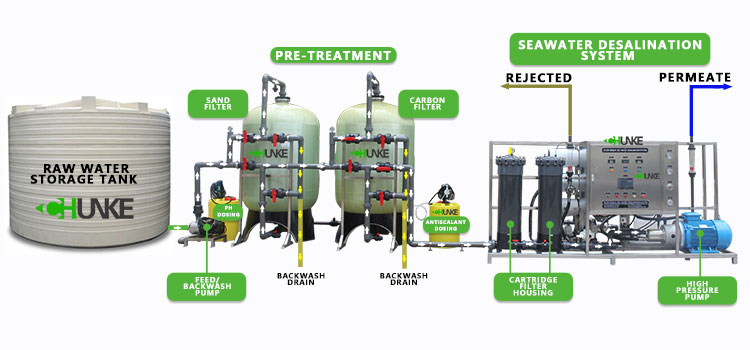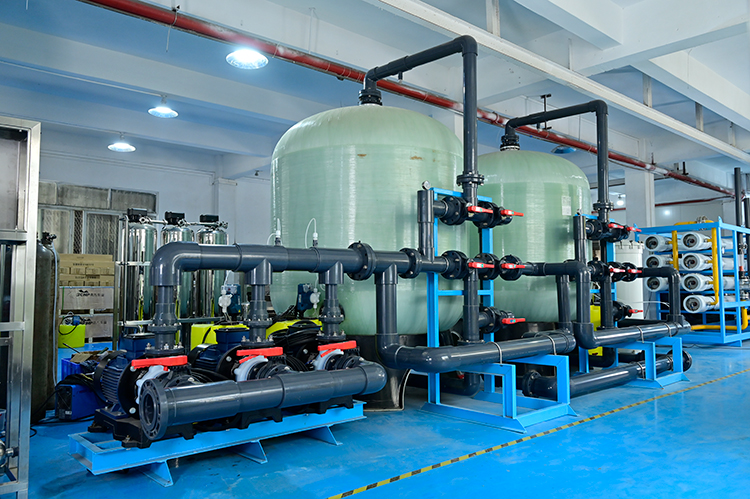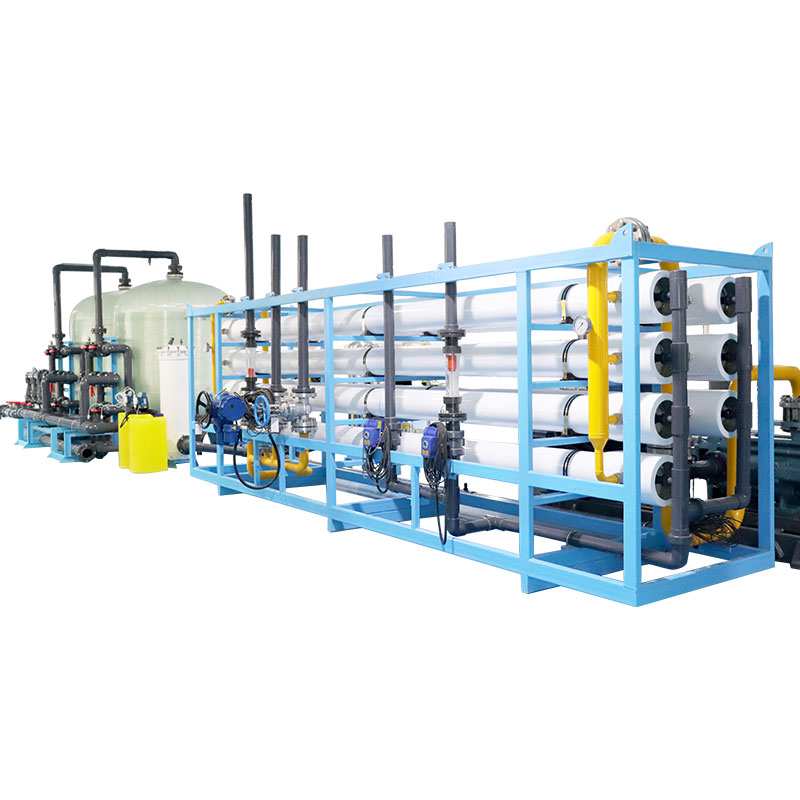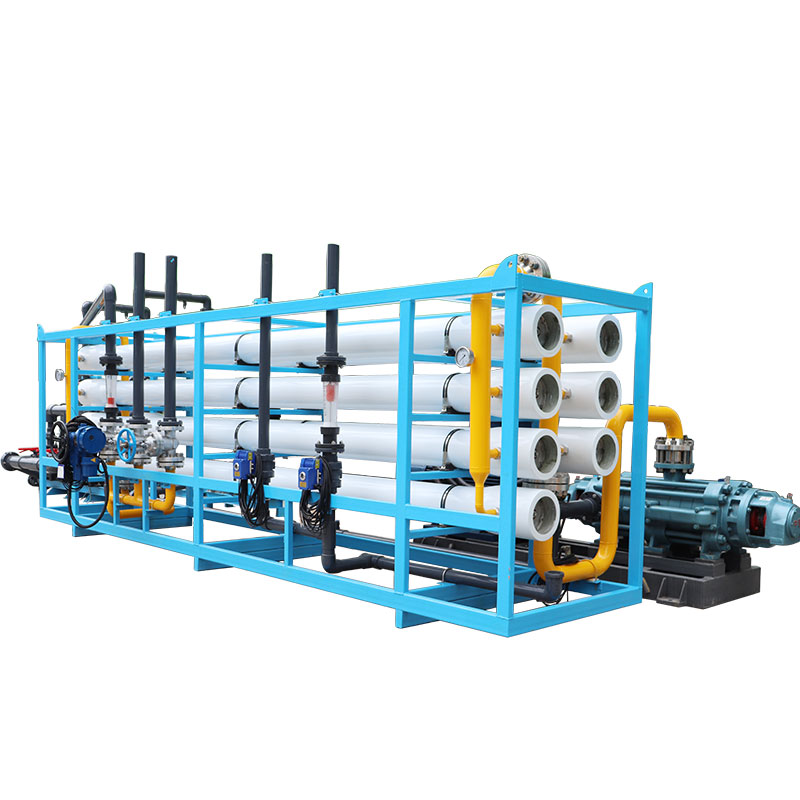Is there a desalination device on board? Is it expensive?
Traditional offshore freshwater supply relies on shore-based replenishment, but this faces many challenges in long-distance voyages and ocean operations. To solve this problem, many modern ships have begun to be equipped with desalination devices.
So, is there really a desalination device on board? Is it expensive? This article will explore the current status, cost and application prospects of desalination devices on board.

Current status of desalination devices on board
1. Working principle of desalination device:
The working principle of desalination devices on board is basically the same as that on land, mainly using reverse osmosis (RO) technology. Seawater enters the reverse osmosis membrane through a high-pressure pump. The pore size of the membrane is extremely small, allowing only water molecules to pass through, while salt and other impurities are retained, and finally fresh water is obtained. Some ships also use thermal desalination technologies such as multi-effect distillation (MED) or vapor compression (VC) to heat seawater to evaporate it and then condense it to obtain fresh water.
2. Equipment:
Currently, many large ships, such as cruise ships, cargo ships, warships and offshore drilling platforms, are equipped with seawater desalination devices. These devices can not only provide drinking water for crew members and passengers, but also meet daily water needs such as bathing, cooking and cleaning. Some advanced fishing boats and yachts have also begun to install small seawater desalination devices to cope with the water problem of long-term offshore operations.

What is the cost of marine seawater desalination devices?
1. Equipment cost:
The equipment cost of the shipboard seawater desalination device mainly depends on the scale and technology type of the device. The price of the reverse osmosis device is relatively low, but it requires a high-pressure pump and a sophisticated reverse osmosis membrane. Thermal desalination devices, such as multiple effect distillation (MED) and vapor compression (VC), have certain advantages on large ships, although the equipment cost is higher.
Take a medium-sized reverse osmosis device as an example, its equipment cost is about 100,000 to 300,000 US dollars. This price includes all components such as the pretreatment system, reverse osmosis membrane, high-pressure pump and automatic control system. The price of thermal desalination devices is higher, usually between 300,000 and 500,000 US dollars.
2. Installation cost:
Installation cost includes equipment installation, commissioning and pipeline connection. Due to limited space on board, the layout and operation convenience of the equipment need to be considered during the installation process. Generally speaking, the installation cost accounts for about 10% to 20% of the equipment cost, that is, between 10,000 and 100,000 US dollars, depending on the type of ship and the complexity of the equipment.
3. Operation cost:
Operation cost mainly includes energy cost, chemical cost, equipment maintenance cost and staff salary. The energy consumption of reverse osmosis device is relatively high, mainly due to the use of high-pressure pump. Taking the reverse osmosis device with a daily output of 50 tons of fresh water as an example, its daily energy consumption is about 1000 to 1500 kWh. Calculated at 0.1 US dollars/kWh, the daily energy cost is about 100 to 150 US dollars.
In addition, the reverse osmosis membrane needs to be cleaned and replaced regularly, and the cost of chemical agents and maintenance also accounts for a certain proportion. Comprehensively calculated, the operating cost of each ton of water of the reverse osmosis device is about 2 to 5 US dollars. Thermal desalination device consumes more energy because it relies on thermal energy, but its maintenance cost is relatively low.

What are the advantages of marine desalination devices?
● Autonomous water supply: Desalination devices enable ships to be independent of shore-based water supply, especially in ocean voyages and long-term offshore operations, to provide a stable supply of fresh water.
● Emergency support: In emergency situations, such as when shore-based water supply is interrupted or the route deviates, desalination devices can guarantee the basic living needs of the crew.
● Environmentally friendly: Modern desalination devices use advanced technology to reduce the use of chemical agents and wastewater discharge, and have less impact on the environment.
What are the challenges of marine desalination devices?
● High energy consumption: The energy consumption in the desalination process is high, especially reverse osmosis and thermal desalination technologies, which require a large amount of energy supply.
● Complex maintenance: The maintenance requirements of desalination devices are high, and professional personnel are required to conduct regular inspections and maintenance to ensure the normal operation of the equipment.
● High initial investment: Although desalination devices can provide ships with a reliable supply of fresh water in the long run, their initial investment is high, which may put economic pressure on some small ships.
Future development trend of marine desalination equipment
1. Technological innovation:
In the future, desalination technology will develop in the direction of higher efficiency and lower energy consumption. For example, the application of nanotechnology and advanced materials will make the filtration efficiency of reverse osmosis membrane higher and the energy consumption lower. The introduction of intelligent control system will further optimize the desalination process and reduce operating costs.
2. Renewable energy:
The use of renewable energy such as solar energy and wind energy to power desalination equipment is an important development direction in the future. In sunny seas, solar desalination equipment has shown great potential. Through solar collectors and photovoltaic panels, directly providing energy for desalination equipment is not only environmentally friendly, but also can greatly reduce energy consumption costs.
3. Policy support:
Governments and international organizations should strengthen support and promotion of desalination technology. Introduce relevant policies to encourage ships to install desalination equipment, provide financial subsidies and technical support. At the same time, strengthen scientific research investment to promote the development and application of new technologies.

Social and economic benefits of marine desalination equipment
1. Improve the quality of life:
The application of desalination equipment has greatly improved the quality of life of crew members and passengers. Whether sailing in the ocean or working at sea, a reliable supply of fresh water guarantees basic living needs and improves work efficiency and life satisfaction.
2. Promote the development of the marine economy:
The progress of seawater desalination technology has provided important support for the development of the marine economy. Especially in the fields of offshore fisheries, marine tourism, and marine resource development, a stable supply of fresh water is an important basis for ensuring production and life.
3. Environmental protection:
By adopting environmentally friendly seawater desalination technology, the dependence on and plunder of natural water resources is reduced, which helps to protect the ecological environment. At the same time, the application of modern seawater desalination technology reduces pollutant emissions and has less impact on the marine ecosystem.
Conclusion
Shipboard seawater desalination devices, as an important technical means to solve the problem of fresh water supply at sea, have been widely used in many modern ships.
Despite the challenges of high energy consumption, complex maintenance and high initial investment, its advantages and potential will be further exerted with the continuous advancement of technology and policy support.




